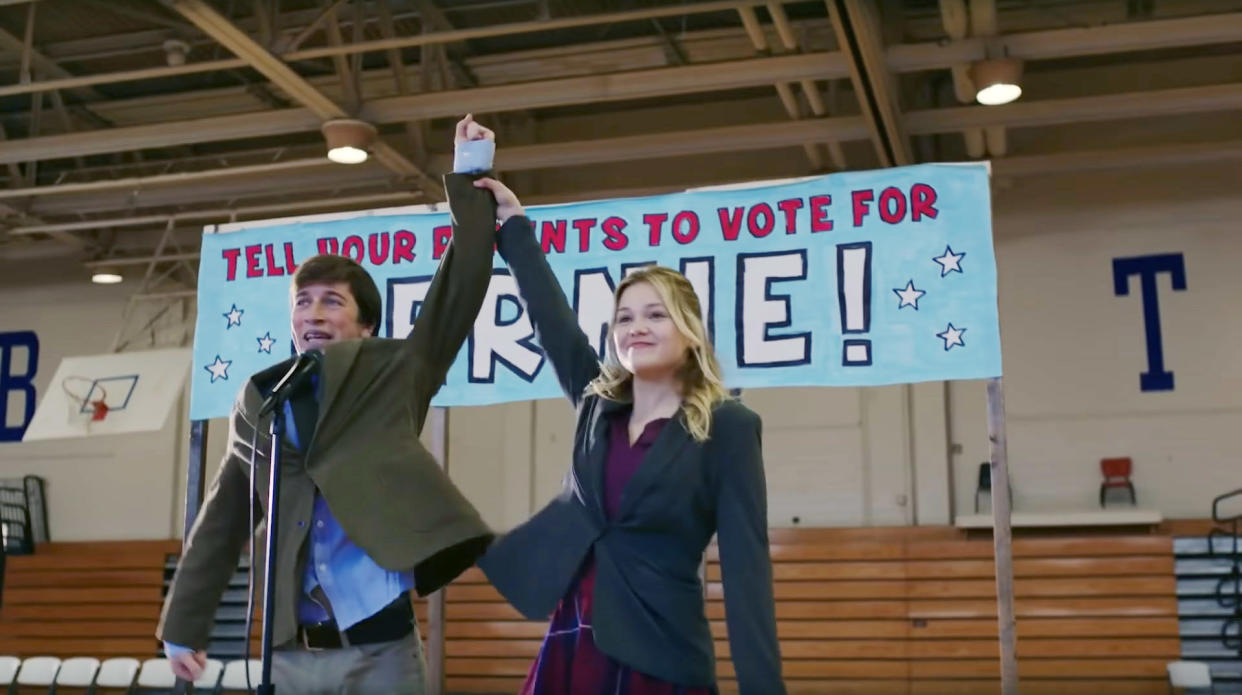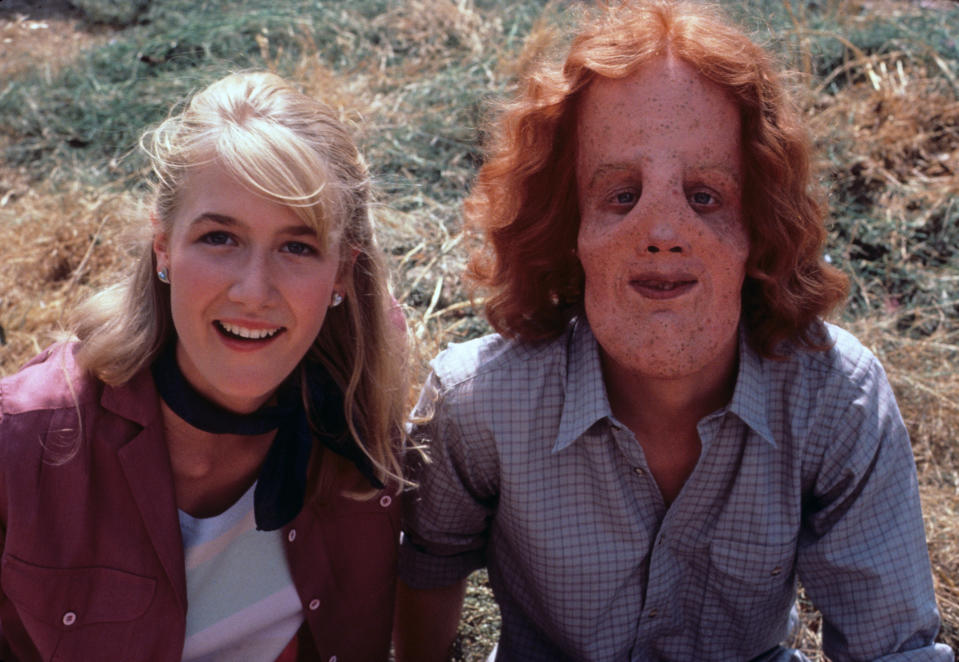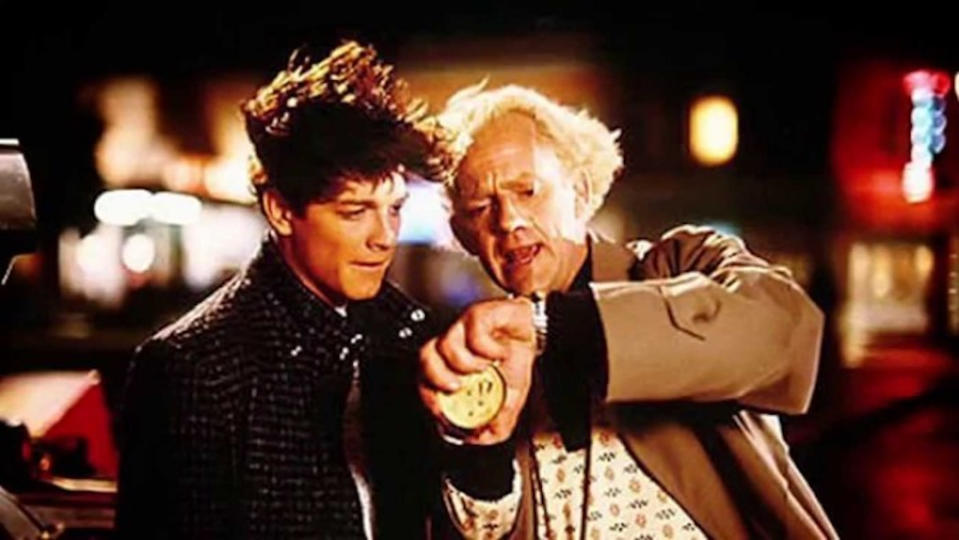Role Recall: Eric Stoltz on his stunning transformation for 'Mask,' that needle scene in 'Pulp Fiction,' and missing out on 'Back to the Future'

Back in the ’80s, Eric Stoltz played some of the decade’s defining cinematic high schoolers, from Mask’s Rocky Dennis to Some Kind of Wonderful’s Keith Nelson. Thirty years later, the 56-year-old actor has graduated to directing the current crop of cinematic high schoolers. Stoltz’s first feature film as a director, Class Rank, opens Friday in theaters and video on demand and stars Olivia Holt and Skyler Gisondo as two teenage oddballs whose paths unexpectedly cross and take them in the direction of an equally unexpected romance. “It’s a conscious effort to get back to the Cameron Crowe and John Hughes feeling,” Stoltz says of the film, name-checking just two of the ’80s teen movie icons that he worked with during that heady era. “I wanted to avoid the fast-cutting, exploitative teen film that seems to have been born in the ’90s.”
While he took his tonal cue for Class Rank from the ’80s, Stoltz emphasizes that he doesn’t feel a lot of nostalgia for those bygone days and how his generation of teenagers compares with the current one. “Honestly, I rarely think back to the ’80s. The one thing that did strike me was that Olivia and Skyler were so driven and passionate about what they were doing. And my memory of the ’80s was that we studied hard, but we also knew how to party!” Despite Stoltz’s lack of interest in looking back, the actor-director kindly joined Yahoo Entertainment for a Role Recall walk down memory lane revisiting some of his signature roles — including the one that famously got away.
Mask (1985)

Just as Stoltz currently divides his directorial duties between episodic television and feature films, he frequently shuttled back and forth between the big and small screens when he started as an actor in the ’80s. Small roles in hit movies like Fast Times at Ridgemont High and guest appearances on vintage TV shows ranging from The Waltons to The Fall Guy led to his big break in Peter Bogdanovich’s acclaimed biopic based on the life of Rocky Dennis, a California teenager living with severe facial deformities caused by craniodiaphyseal dysplasia. The role required Stoltz to submit to an intensive makeup process to transform his own face into Rocky’s. (Mask’s makeup team of Michael Westmore and Zoltan Elek later won an Oscar for their work.)
“Nobody knew who I was at the time, so they just thought that I was the actual guy,” Stoltz remembers now. “We were shooting in the town he was from, and this one time I was walking around at lunchtime and someone shouted his name out of a car!” But not all of his interactions with passersby were as innocuous. “People would not be entirely kind. It was a very curious lesson to walk a mile in that boy’s shoes. Humanity revealed itself to be a bit ugly, at times.” And viewers who grew up on Mask couldn’t help but draw connections between that film and last year’s surprise box-office smash Wonder, which told the fictional story of another boy whose face didn’t look like anyone else’s. “I thought that was a lovely film,” Stoltz says. “Being treated poorly because of how you look or don’t look is a very familiar phenomenon, and I thought that movie handled it very well indeed.”
Back to the Future (1985)

In an alternate timeline — one not created by Biff Tannen — there’s a version of Robert Zemeckis’s beloved comedy that still features Stoltz as time-traveling teen Marty McFly. In our reality, of course, the actor was famously replaced midway through production by Michael J. Fox, resulting in one of the biggest what-ifs of contemporary movie history. Asked whether he ever thinks about a universe where he’s still driving Doc Brown’s DeLorean, Stoltz replies, “I never have, no. I rarely, if ever, give it any thought at all.” He does allow that he’d happily work with Christopher Lloyd again but doesn’t have any treasured memories of his time on set. “Not a one,” he says. “I’m so busy with my life and all that’s happening now, I honestly couldn’t be bothered to think about what might have happened 35 years ago.”
Some Kind of Wonderful (1987)

Legend has it that John Hughes penned this high school romance as a direct call-and-response to Pretty in Pink, switching the genders in the three points of the love triangle from Andie (Molly Ringwald), Duckie (Jon Cryer), and Blane (Andrew McCarthy) to Keith (Stoltz), Watts (Mary Stuart Masterson), and Amanda (Lea Thompson). He also made a point of retaining his preferred original ending to Pretty in Pink, where the two working-class friends get romantic instead of the central character walking into the sunset with the rich and popular love interest. But Stoltz says Hughes never directly addressed the similarities between the two films on set. “He said a lot of other things, but not that,” the actor says, laughing. “He had his particular genre, the teen fable.”
Hughes’s Pretty in Pink muse, Molly Ringwald, recently penned a New Yorker piece where she talked about revisiting those seminal movies and noting how they haven’t aged particularly well. Stoltz says that he read and enjoyed Ringwald’s article but it didn’t prompt a similar re-evaluation of Some Kind of Wonderful on his part. “I rarely, if ever, look back at what I’ve done and think about how it might or might not play today,” he confesses. At the same time, he does see some flaws in Hughes’s version of the teen fable. “I always felt it was largely based on a strange class structure that punished people for being rich and beautiful and glorified the poor and scrappy. It’s a bizarre cousin to those Horatio Alger stories where how much you have or don’t have affects everything. That’s not far from the truth, but I thought it was a little curious at the time.”
Say Anything… (1989)
Stoltz had a small part in Cameron Crowe’s 1989 classic as high school party host Vahlere but played a much larger role behind the camera as a production assistant — a role he volunteered for to observe the art and science of filmmaking in action. He has been a regular presence in Crowe’s orbit since, making small but memorable appearances in Singles and Jerry Maguire. “I learned so much from working with Cameron,” he says now. “You’ll notice that he fiercely loves and protects all the characters in his stories, flaws and all. There’s never any clear villain, really. He allows his characters to surprise you with their behavior in ways you might not have seen coming, and that makes it much more interesting. You never know what’s going to happen with the people you love — everybody’s constantly changing.”
The Waterdance (1992)

Seven years after Mask, Stoltz portrayed another real-life person who wrestled with disability. Waterdance co-director Neal Jimenez used his own hiking accident — which left him in a wheelchair — as the basis for the semi-autobiographical story of Joel Garcia, who has to mentally and physically adjust to life as a paraplegic. “I stayed in the wheelchair during that film, just to get a sense of what it was like,” Stoltz says. “And it was not easy! That was the year after the Americans with Disabilities Act was passed, and they were supposed to be creating ramps on all the sidewalks, but nobody had. It was kind of extraordinary how difficult it was to get around, and how people either forced their help upon you or turned away sort of embarrassed and didn’t offer to help. It was a tricky thing to navigate, dealing with people from a wheelchair.”
Pulp Fiction (1994)
As a director, Stoltz doesn’t consider himself to be an auteur. “I think of myself as a contributing force,” he explains. “The script is where it starts, and then the actors and directors have a point of view, and we try to bring all we can to it. I wouldn’t call that authorship; I would call it a natural growth into what it needs to be.” On the other hand, he definitely views a filmmaker like Quentin Tarantino as the primary author of movies like his era-defining hit Pulp Fiction, in which Stoltz played low-key L.A. drug dealer Lance. “If Quentin was frustrated with a shot, he would run in, grab the camera, and start filming it himself. He’s a bit of a madman; his passion for film is intoxicating and inspires the cast and crew.”
As Stoltz recalls, Tarantino wasn’t operating the camera for the famous adrenaline-shot sequence, where Lance and his wife, Jody (Rosanna Arquette), bring Mia Wallace (Uma Thurman) out of her heroin-induced overdose. “There was a shot where John [Travolta] and Uma are supposed to drive the car into my house; stunt people drove a car, and I’m supposed to go to the door, and the door was supposed to break and shatter when the car hit the house, but it never did! I remember that shot was frustrating for Quentin, because they never got the glass to shatter properly. At one point, he did grab the camera and said, ‘I’m going to do this. Come on, everybody!’ And by the way, it was also 3:30 in the morning and the whole neighborhood was lit up. Making movies is a crazy profession.”
Class Rank (2018)

Stoltz is still gainfully employed as an actor, but Class Rank represents his preferred role as a director. (That said, he also indulged his acting side by casting himself in a blink-and-you’ll-miss-it part.) “I would hope that being an actor has helped me in my directing, because one thing I try to do is I prioritize performance over technique,” he says. “I try to meet the actors where they are, and bring out the best in them.” It helps when he identifies with a character like Class Rank’s outsider hero, Bernard (Gisondo), a socially awkward teen who mounts a campaign to win a spot on his community’s school board at the behest of overachiever Veronica (Holt). “I felt the exact same way as Bernard growing up — completely disconnected from what the popular kids were interested in. They’re outsiders. They’re so far outside, they’re not even aware that they’re outsiders! Or they don’t care, rather. That’s also different than in the old ’80s movies; these guys may be outsiders, but they don’t see any need to try and be like everyone else in the crowd.”
Class Rank is now in theaters, on demand, and digital.
Read more from Yahoo Entertainment:

 Yahoo Movies
Yahoo Movies 

